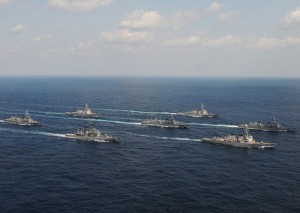From July 25 to August 1 Japan joined joint naval exercises of United States and Indian warships codenamed “Exercise Malabar”. This fact attracted the attention of both military and political analysts, specializing in the assessments of the situation in the Asia-Pacific region, as well as in the Indian Ocean region.
These two regions are increasingly often regarded as a single unity. This has largely been provoked by India’s transition to the role of the world’s leading player, which sphere of interest is beginning to exceed the waters of the Indian Ocean, mainly in the eastern direction. At the same time China and Japan, the other two Asian giants, are beginning to show increased attention to the Indian Ocean.
The rendezvous point of this year’s exercise is truly remarkable – the ships were gathering at the Japanese port of Sasebo, located on the island of Kyushu – the southernmost of the four main islands of Japan. This port was one of the main bases of the Imperial Japanese Navy, and after the Second World War it became home to the United States Seventh Fleet. Sasebo provided logistical support for the American Navy during the Korean and Vietnam wars, along with various armed conflicts in the Middle East in the past few decades.
Sasebo today is an important base for the navies of the United States and Japan. And if the observers and the media invited to this year’s exercise grew accustomed to see Japanese and American ships in the harbor waters, the presence in the united squadron of the Indian Navy provided them with a cause for observations that go far beyond the actual “naval” framework.
The fact is that it wasn’t India that joined a variety of traditional US-Japanese military exercises, but rather Japan (for the third time) joined the US-Indian “Exercise Malabar” which is held annually since 2005. But for the first time ever the exercise area has been moved from the Bay of Bengal in the Indian Ocean to the western Pacific Ocean.
In this regard, the commentators didn’t have any doubts about the anti-Chinese overtones of the latest exercise. Although the official script was formulated in neutral wording and was limited to countering the threat of “terrorism and piracy on critical maritime trade routes.”
But in the actual area of the exercise “terrorists” or “pirates” hasn’t been seen for a long time. But it was adjacent to the areas of territorial disputes in the East China and South China Seas.
Last years saw a number of “politically correct” excuses for military demonstrations held by the world’s leading players. The official version of the latest “Exercise Malabar” wasn’t associated with real concerns in somebody’s respect, but with some unknown “terrorists” and “pirates.”
As for the actual terrorists and pirates they provide no explanation of the possible causes of their “aggression”. Apparently because they, most often, can neither read nor write. But their self-esteem would increase dramatically if they are to be told that they are the main cause of such exceedingly expensive and large-scale events as the above discussed exercise.
In the same manner Indian side provided a number of “politically correct” excuses for moving the operational area of “Exercise Malabar” from the Bay of Bengal to a few thousand miles to the east. It happened so that an Indian destroyer and a frigate were conducting a joint exercise “Indra” with the ships of the Russian Pacific Fleet, and on the way home they stopped at the port of Sasebo. Where, as stated above, the USA and Japan ships were stationed “for no apparent reason”. Why go somewhere else?
It is clear that the format of the exercise was planned at the beginning of the year and was in no respect random, it was governed by the fundamental considerations that govern the development of the regional political game. Since India was behind the planning of this exercise it decided to invite Japan. This step was taken by the former Indian Prime Minister Manmohan Singh when his Japanese counterpart Shinzo Abe was visiting New Delhi back in January.
In recent years, there has been a number of speculations that United States, Japan and India can form something like an “Asian Triple Alliance” directed against China. The operational area and the format of this year’s “Exercise “Malabar” may be used by authors of such hypotheses to their advantage.
However, American policy towards China shows no desire to get into direct confrontation, especially when the cause of such a confrontation is relatively unimportant. This can serve as an explanation for the fact that Chinese navy participated in this year’s exercise RIMPAC that is held every two years and governed by the American “Pacific Command.” The operational area of RIMPAC was almost identical to the are of this year’s “Exercise Malabar”.
Apparently, Beijing should be more concerned with the other two participants of the exercise, since the last few years has been marked by comprehensive steps of bilateral rapprochement. It is possible that the new Indian government headed by Narendra Modi can give this process a new momentum.
Vladimir Terekhov, leading research fellow at the Center for Asian and Middle Eastern Studies at the Russian Institute of Strategic Research, exclusively for the online magazine “New Eastern Outlook”.
